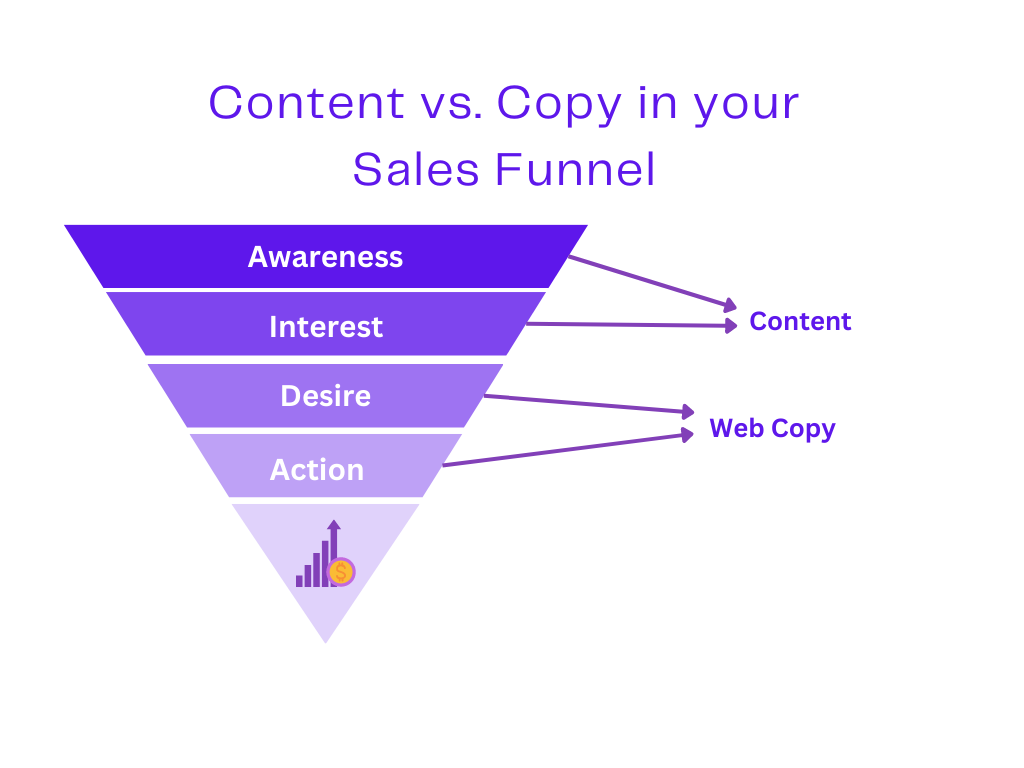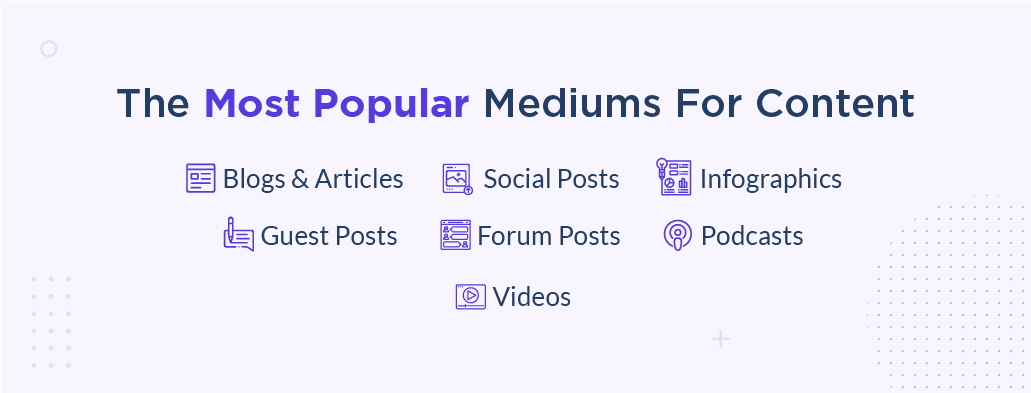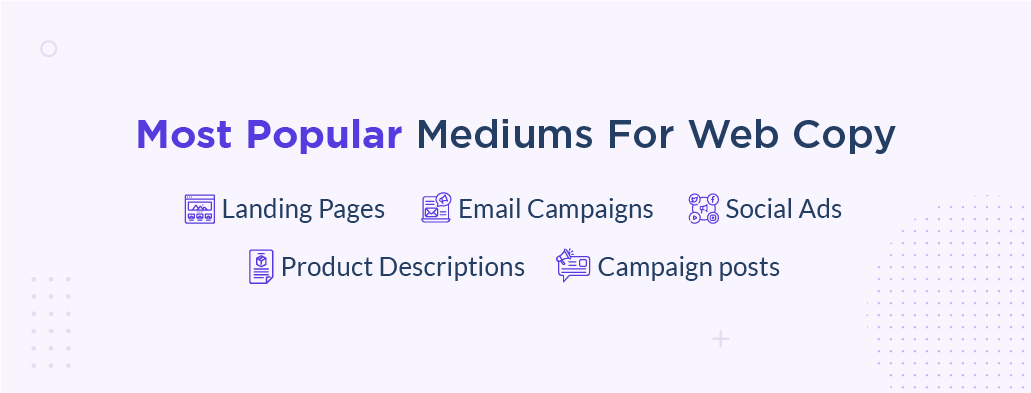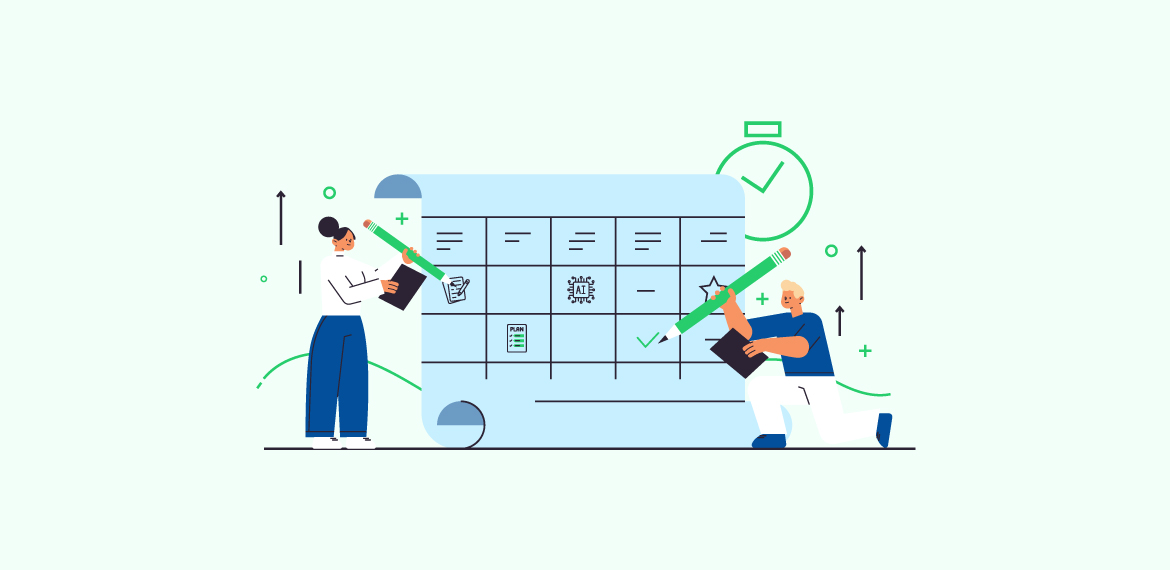- Content Marketing
Using Content and Copy to Optimize your online Sales Funnel

Introduction:
They say content is king, and it really does play a major part in ensuring your website ranks up the SERPs, gets traffic, and even conversions. Many consider it the core foundation on which a website stands.
But web content doesn’t encompass everything on your website by any means. In fact, the web content definition we just gave isn’t completely true. What we defined was the perfect combination of web content and web copy.
If you aren’t mad for content or can’t be considered a content enthusiast, we would understand that you can get confused about copy vs content. No worries though, as we’re here to clear up the difference and tell you how you can actually use both of them to optimize your website’s user journeys.
So let’s begin with an unclear quote, “All Copy is Content, but not all Content is Copy”
and we can assure you that by the end of this article, you’ll not only understand but will know how to use it too. Let’s start by answering the question below.
What is Web Copy?
Web Copy is basically content written with the purpose of getting an action from your website visitor. Depending on your business, you might have different objectives that need to be achieved from your copy. A single website might even be going for different objectives with different copies too.
Moreover, copies aren’t only written on websites. In fact, if you ever ask the question, “What is a web copy?” from a social media manager, they’ll likely define social media copies before moving on to landing pages. Our service of product descriptions is the best example for writing web copy. This is because product descriptions are specifically written to get the customer to purchase.
Also, because copy looks for action from the reader, they are always crafted to be more interesting and shorter than other content. When writing web copy, the writer is always thinking of ways to pull in the reader. Once the reader is interested enough, the writer brings forth the CTA (Call-to-Action). The CTA is the desired action the Web Copy demands, and the likelihood of achieving it depends on how strong the web copy was.
What is Web Content?
Web content, on the other hand, is anything and everything written and viewable on the website. It could be your About page, your landing page, and even your contact page. However, many confuse web content with just text, whereas web content encompasses everything.
Even your images, infographics, and videos come under the web content definition. The main focus of your content is usually to keep your audience interested in what you’re telling them. This is why one immediately thinks of “blogs” upon hearing web content. But apart from blogs, content can take many other forms too, all centered towards keeping the user engaged.
Content is also used to get more traffic and educate the audience. Websites use content so that they can rope in viewers and begin the journey through the sales funnel. The idea is to get the customer aware and interested.
Web Copy vs. Content
The main difference between copy and content should be quite clear by now. As content is more focused on getting a user interested, it usually comes at the top side of the sales funnel. However, as the copy is more focused on getting action from the user, it typically comes at the lower end of the sales funnel.
To better represent copy and content in a sales funnel, have a look at the image below:

You can see that it is important that content and copy are both present in a proper sales funnel too. In fact, you can apply this logic to your own sales funnel too, and you’ll see that content will mostly rank where you’re grabbing attention by providing information. Similarly, you’ll also see copy coming up where you’re probably looking for the user to convert, or purchase from you.
The most popular mediums for Content

While content can be virtually anything, the objective behind creating it should be crystal clear. In fact, it is best to have the end goal in mind even before going towards content creation. And if you have the sales funnel in your sights as well, then you also have the means to formulate a whole campaign.
Content is normally found in:
- Blogs & Articles: These are typically in Long format, elaborating multiple details to either solve a problem or charm the readers.
- Social Posts: Social posts are often used as a medium to engage with prospective and existing customers. The main idea behind social posts is to attract the audience toward the brand and then toward the website.
- Infographics: This is a popular content medium where an image explains a complex idea in detail. Infographics summarize a concept and are often appreciated by website visitors. Good infographics are even shared online which can further improve brand recognition.
- Guest Posts: Websites often create blogs and articles and post them on other blog websites, as these websites already have a more extensive viewership. The idea is the add a link to your own website in the content to redirect readers toward your own platform.
- Forum Posts: Forums have a large audience who are often there to discuss solutions. Marketers know that they can often garner a lot of viewership by helping prospective customers there via content. Forum posts ensure information to the right audience is provided efficiently.
- Podcasts: Podcasts are a great medium to increase awareness. The format can be audio or visual and can have a significant impact at how a layperson views a brand
- Videos: Video content is most often used to either hook the customer or provide a tutorial. As visual tutorials are easier to understand a larger audience can be engaged with this medium.
While sometimes you might find a hint of a copy within them but that isn’t the norm, at least yet. However, one thing you should pick from this list is that the right mind can repurpose a single idea into every one of these mediums. This is known as repurposing content. Repurposing is fairly common with content and quite rare with the web copy.
Most popular mediums for Web Copy

You’ll most likely see web copy in the following mediums:
- Landing Pages: These are web pages specifically designed for campaigns. These are all about selling your product to your customers through a special offering, so often contain a lot of web copy.
- Email Campaigns: They are often drafted by websites to get customers to either visit landing pages or buy directly from pages focused on conversions.
- Social Ads: Social Media ads are used to get conversions from either your followers or your set audience on social media platforms. Copywriting in this medium typically follows the type of audience you have along with the norms of the platform itself.
- Product Descriptions: Copy is always focused on getting conversions, and product descriptions are aligned with this goal. This is why web copy is always dominantly present in Product Descriptions, with hints of SEO elements too.
- Campaign posts: Web copy is also quite popular on social posts as well as blog posts created for campaigns. These often redirect to the landing page or to the product advertised.
While you can apply a single copy idea and try to use it in every medium, you’ll find it fairly difficult and at times impossible too. For example, what you have written in your product descriptions will most likely feel out of place in your campaign posts where you’re offering lowered prices. The reason is simple, product descriptions talk about a product, but campaign posts talk about a special offer.
Moreover, people might connect with old content, but if they recognize an overused copy, they tend to get annoyed. It is one of the reasons why we often dislike when the same ad pops up every time we use YouTube.
Synergizing Copy and Content
you to create pieces that boost your presence like never before.
These are the times when copy and content mix together too. For example, if you have written a blog and have a special offer going on, you might announce it at the end or wherever appropriate.
Imagine your blog like an infomercial, you’re basically informing your prospective customer that you are aware of their problem, then you scale that problem to demonstrate it being too troublesome. After that, you plug in your product/service which promises to solve the problem and then you bring up your CTA telling the reader to buy from you and attain happiness.
This whole process is usually referred to in marketing circles as using storytelling to get conversions. You’ll find that expert writers are almost always acutely aware of this tactic, which is one of the reasons brands go to them to get the perfect mix of content and copy.
However, we feel we must also discuss a few caveats of mixing copy and content. The first problem you’ll find is being at a loss to know how long your piece should be. Since copy is supposed to be precise and to the point, and content is supposed to be elaborative, finding the right word count can be difficult.
Similarly, your audience requires a resonating tone, which will definitely shift gears once content ends and copy begins or vice versa. Then there is the added trouble of knowing how your audience works well. You need to know the priority your audience is giving to the problem you’re solving.
While highlighting the problem you need they should feel that you understand them, so the pitch should be of a friend, not a salesperson. And by the end of your piece, they should be aware of how to solve their problem, through your product. In other words, you ensure that your website visitor follows the user journey and the sales funnel simultaneously.
We know this can be quite a daunting task, which is why our expert writers are ever ready to provide you with the perfect mix you’re looking for. If you’d like to check out our services we’ll happily tell you about them here.
If you have any further questions about content, copy, or even writing, feel free to comment or get in touch with us.
Kickstart your first project
- Easy Order Process
- Vetted team of writers
- 100% original content



